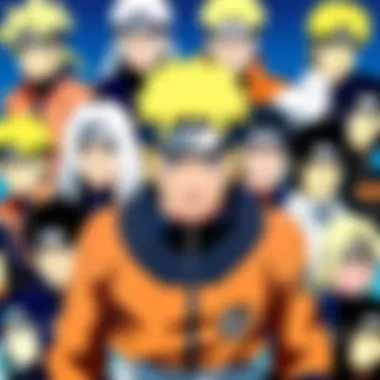A Complete Guide to Watching Naruto: Insights and Arcs


Intro
The world of Naruto captivates many with its rich storytelling and complex characters. For those diving into this renowned universe, comprehending the multilayered narrative can at times feel overwhelming. This guide aims to shed light on the essential aspects of Naruto, empowering both newcomers and seasoned fans to navigate its intricate pathways with ease and appreciation.
With a multitude of character arcs, dramatic moments, and thematic depth, the journey through the Hidden Leaf Village offers not just entertainment but also profound life lessons. Whether you’re just starting or revisiting the series, understanding how the pieces fit together can enhance your viewing experience tremendously. Let's take a closer glance at the elements that make Naruto a groundbreaking series in the anime landscape.
Preamble to Naruto
In the world of anime and manga, few titles have left as significant a mark as Naruto. This series isn't just about ninjas; it dives deep into themes of resilience, friendship, and the quest for belonging. For anyone looking to immerse themselves in the franchise, understanding its backbone is vital. This section provides an introduction to the world of Naruto, setting the stage for a profound viewing experience.
Overview of the Franchise
Naruto, created by Masashi Kishimoto, made its debut in 1999 as a manga serialized in Weekly Shōnen Jump. Its transition to anime began in 2002, capturing audiences worldwide. The tale follows Naruto Uzumaki, a young ninja with dreams of becoming Hokage, the leader of his village. What starts as a simple yet engaging story evolves into an epic narrative filled with rich character development and intricate plotlines.
The franchise spans multiple arcs, each contributing to the overarching narrative while introducing new characters and challenges. With two primary series—Naruto and its sequel, Naruto Shippuden—plus various spin-offs and adaptations, the franchise has cemented its place in popular culture. From video games to movies, Naruto has transcended its origins, influencing a generation of creators and audiences alike.
Fans and newcomers alike will find something to appreciate here, with each episode leaving you craving more. That’s the charm of this franchise; it enchants viewers with a mix of action, character depth, and relatable themes.
Historical Context of Naruto
Emerging during a pivotal time in anime history, Naruto reflected societal shifts and cultural nuances of Japan in the early 2000s. The rise of global internet access led to a new wave of international anime viewers who embraced the series' unique storytelling style. This expansion helped establish a bridge between Eastern and Western cultures, allowing the franchise to flourish globally.
It's critical to acknowledge how Naruto skillfully intertwines modern themes with traditional Japanese storytelling. The series explores the concept of the 'ninja'—an archetype deeply rooted in Japanese history—while interjecting contemporary issues like the struggle for identity and the importance of community. When you watch Naruto, you're not just observing battles and friendships; you're witnessing an exploration of personal growth, acceptance, and emotional healing.
In short, the context in which Naruto thrived was critical for its acceptance and impact. The world was ready for tales of underdogs overcoming adversity, resonating with viewers far and wide. This section lays a crucial foundation for understanding the rich narrative that follows.
Understanding the Main Plot
In the grand tapestry of the Naruto series, understanding the main plot is essentail. The narrative follows the life journey of Naruto Uzumaki, an ambitious young ninja with dreams of becoming the strongest leader, the Hokage, of his village. This overarching goal serves as a tether, uniting various events, character developments, and thematic elements across the entirety of the franchise. For new viewers, comprehending the main plot is pivotal for appreciating not just the action sequences but the deeper emotional currents that drive the story forward. The interconnections between various arcs and the evolution of Naruto’s character underscore the importance of grasping this central narrative.
The Journey of Naruto Uzumaki
Naruto's journey is not merely a series of battles or adventures; it represents a profound coming-of-age saga. Starting as an ostracized child, he grapples with the legacy of the Nine-Tails beast sealed within him, facing prejudice and loneliness. As he progresses, viewers witness his transformation—from a rough-edged troublemaker into a mature, inspiring leader. This evolution is remarkably relatable; many can empathize with the struggle to find one’s place in the world.
Key Story Arcs and Themes
The richness of Naruto's tale lies in its diverse arcs, each imbued with unique themes and character conflicts that resonate with the audience. Four central arcs particularly stand out:
Ninja Academy and Early Adventures
In the Ninja Academy arc, the story sets the stage for Naruto’s initial struggles and early friendships. Here, the audience witnesses the camaraderie that blossoms among Naruto, Sasuke, and Sakura, laying a strong foundation for future dynamics. A key characteristic of this phase is the blend of humor and earnestness, which makes it a popular choice among fans. The unique feature of these early adventures is the learning process; we see Naruto's determination to prove himself, showcasing his resilience and drive. While some may argue these episodes feel less intense compared to later arcs, they are crucial for establishing character backgrounds and motivations.
Chunin Exams


The Chunin Exams arc ramps up the stakes, introducing a wide array of characters, each with their distinct abilities. This arc not only serves as a battleground for skill exhibition but also propels Naruto’s development. A prominent aspect is the conflict introduced by formidable opponents, such as Gaara and Orochimaru, who challenge Naruto and his friends to push beyond their limits. The detailed portrayal of rivalry and friendship in this arc is significant—it underscores the balance between competition and comradery, making it a compelling section of the series. One might argue that the complexity added to the plot here is a double-edged sword; while it enhances the narrative, some viewers may find the pacing overwhelming.
Rescue Missions
The Rescue Missions arc is character-driven, offering insight into the bonds of friendship and loyalty. It highlights Naruto's determination to save Sasuke from darkness, showcasing the emotional stakes involved. This arc's unique feature is its exploration of pivotal relationships; themes of sacrifice and brotherhood surface as important characteristics. Although some might find the emotional intensity challenging, it reinforces the story's depth, compelling fans to invest more in the characters involved.
Confrontations with Major Villains
Confrontations with major villains serve as climactic moments that define the emotional and thematic landscape of the series. Characters like Pain and Madara Uchiha are not mere antagonists but vital forces that test Naruto's resolve and belief system. Their interactions deepen the philosophical underpinnings of the series—questions of power, redemption, and the cycle of hatred come into sharper focus. The advantage of these confrontations is their ability to provoke thought and spark discussion among viewers, pushing them to contemplate broader societal issues. However, a downside might be the layout of intense action that can overshadow character moments, which some viewers may find disatisfying.
The main plot of Naruto is akin to a sprawling tree, with each arc representing branches that expand the storyline and deepen viewer engagement.
Character Analysis
The characters in Naruto are not just mere figures in an anime; they are the heartbeat of the series. Through their development, struggles, and triumphs, viewers gain insights into the broader themes of friendship, resilience, and loyalty. This character analysis dives into pivotal figures, showing how their growth and complexities enrich the overall narrative.
Naruto Uzumaki: The Protagonist's Growth
Naruto Uzumaki stands at the forefront, embodying the series' spirit. His transformation from a lonely, ostracized child to a powerful ninja serves as an inspirational story of perseverance against all odds. He begins with a loud, brash personality, often acting without thinking. However, the journey helps him cultivate a deeper understanding of himself and others.
Crucially, Naruto’s desire to be acknowledged fuels his commitment, showcasing the theme of hard work. His ninjutsu skills, especially the development of the Shadow Clone Technique, symbolize the growth stemming from his relentless efforts. Moreover, his relationships with others—especially with his rivals and friends—fine-tune his character arc, reflecting empathy and a sense of community. All this underpins what it means to truly grow and evolve beyond one’s origins.
Supporting Characters: A Closer Look
While Naruto’s journey is paramount, the supporting characters significantly contribute to the depth of the narrative.
Sasuke Uchiha
Sasuke Uchiha serves as both rival and friend to Naruto, embodying the theme of duality. From a young age, Sasuke is fixated on revenge against his brother, who tragically took the lives of their clan. This singular focus allows us to explore darker themes like obsession and the impact of loss. Sasuke's evolution encourages discussions on redemption—as he grapples with the consequences of his decisions.
His key characteristic is his incredible skill as a shinobi; this distinguishes him as one of the strongest members of their generation. The unique feature of his Sharingan enables him to read opponents during battle, giving him strategic advantages. However, this pursuit of power sometimes blinds him to friendships, demonstrating the drawbacks of isolation in the quest for vengeance.
Sakura Haruno
Sakura Haruno adds a vital layer to the team dynamics. Initially portrayed as emotionally weak compared to her male counterparts, her journey reveals tremendous development in strength and resolve. Her growth may not be as immediate or flashy as Naruto’s or Sasuke’s, but it is significant in its own right. When she becomes a skilled medic and a proficient fighter, she underscores themes of inner strength and resilience.
Her key characteristic is resilience; she evolves into a dependable ally rather than just a love interest. This shift highlights the importance of personal growth. Yet, her vulnerabilities are also her unique features, allowing audiences to relate to her struggles. Thus, Sakura reminds viewers that everyone has their battles, and growth is often a gradual process.
Kakashi Hatake
Kakashi Hatake, the enigmatic teacher of Naruto, Sasuke, and Sakura, represents wisdom amid chaos. His character often embodies the burden of loss, as he carries the weight of his past decisions and sacrifices. This depth makes his guidance pivotal to Naruto’s character growth.
Kakashi’s most notable characteristic is his calm demeanor paired with profound insight; he teaches important lessons about life, focusing on teamwork and trust. A unique feature about him is his Sharingan, which he uses strategically, adding to his enigmatic persona. However, his past also carries disadvantages; at times, it causes him to distance himself emotionally from his students. This depiction of a mentor with vulnerabilities resonates especially with adult audiences, who see reflections of their life's complexities.
Villains and Their Motives


The villains in Naruto add layers of conflict and moral ambiguity, making the series more compelling. Unlike typical evil characters, many antagonists have relatable backstories, allowing viewers to empathize with them. This is crucial in understanding their motives—be it revenge, ideology, or misguided zeal.
A noteworthy aspect of these villains is their depth; each has a unique goal that can inspire viewers to think critically about right and wrong. Such complexity enriches the narrative, making it not just a story of good versus evil.
While these villains challenge Naruto and his friends, they also make characters grow stronger and wiser. Their existence serves as a reminder that one's path is often shaped by experiences rather than a predetermined fate, inviting viewers to question the nature of their struggles and motivations.
This character analysis aims to elucidate how these figures enhance the narrative, offering viewers an opportunity to connect deeply with their journeys.
Cultural Significance
Understanding the cultural significance of Naruto extends beyond mere entertainment; it informs us about societal values, interpersonal relationships, and universal themes of perseverance. The series stands as a beacon, illuminating its impact on the world of anime and manga, and showcasing how it has shaped narratives across various media. Fans and skeptics alike recognize that Naruto isn't just a story about ninjas—it's an intricate tapestry woven with threads of tradition, modernity, and human emotion.
Influence of Naruto on Anime and Manga
Naruto played a pivotal role in the rise of shōnen manga, influencing countless series that came after it. Elements such as character development, thematic depth, and the quest for identity have become staples of the genre thanks to the foundation laid by this series. Its detailed world-building and the intricacies of ninja techniques presented a new standard for storytelling.
For instance, many contemporary anime, like My Hero Academia, owe their popularity, at least in part, to the influence of Naruto. The establishment of relatable characters, combined with their journeys of growth and discovery, resonates widely with audiences. Here's why Naruto matters:
- Creating a Template: The series established a clear template for character arcs and adventure quests, where the protagonist is often an underdog.
- Broader Appeal: With its mix of action, humor, and deep emotional moments, Naruto garnered a wider audience, making anime accessible to many.
- Cultural Representation: Introduced global audiences to Japanese culture, from the importance of teamwork to the significance of rituals, providing insights into values that transcend cultural boundaries.
Themes of Friendship, Hard Work, and Redemption
At its core, Naruto champions the themes of friendship, hard work, and redemption, which are not just mere plot devices but core tenets from which the story flourishes. These themes speak directly to audiences, allowing for personal reflection and connection.
"The series encourages viewers to think about their own struggles and triumphs in life, proving that effort and bonds with others can lead to redemption and future aspirations."
- Friendship: The relationships between characters showcase loyalty and camaraderie, emphasizing that connections can empower individuals to achieve great things. Naruto's bond with Sasuke, despite the latter's initial antagonism, underscores the series' inclination toward forgiveness and understanding.
- Hard Work: The mantra of working hard is illustrated through Naruto's unyielding dedication to become Hokage. His journey exemplifies that self-improvement comes not from innate talent but rather from relentless effort and facing one's fears head-on.
- Redemption: Characters like Sasuke and Gaara reflect this theme poignantly. Both undergo their transformations through battles with their pasts and the acceptance of their mistakes. Their arcs serve to remind viewers that redemption is attainable, reinforcing that everyone has the potential for change, no matter how bleak the circumstances.
How to Approach Watching Naruto
When diving into the Naruto series, it is essential to have a clear strategy. Watching Naruto might seem straightforward, but it can quickly spiral into a jumbled mess if one isn't careful with the viewing approach. The series is vast, comprising two distinct shows: Naruto and its sequel, Naruto Shippuden. Additionally, the presence of filler episodes can add to the confusion. By adopting a structured approach to viewing, you'll not only appreciate the core narrative but also grasp the themes and character arcs more deeply.
Recommended Viewing Order
Naruto and Naruto Shippuden
The journey begins with Naruto, which introduces us to the titular character and lays the foundational elements of the story. After concluding this first part, viewers transition into Naruto Shippuden, which takes place a couple of years after the original series and showcases a more mature Naruto along with his friends.
This natural progression signifies the effective character development that takes place, highlighting how far the characters have come.
The key characteristic of this two-part structure is its immersive storytelling that evolves as the characters age. Choosing to watch in this order provides a cohesive narrative experience, ensuring viewers are not jumbled in timelines or plot developments.
However, those familiar with the franchise may find the pacing of Naruto a tad slower. But fret not; this allows ample time to understand character motivations and relationships, which pay off spectacularly in Shippuden.


Filler Episodes and Their Place in the Series
Filler episodes often confuse viewers due to their lack of direct relevance to the main plot. These episodes, sprinkled throughout Naruto and Shippuden, serve as a breather from the intense storyline. Notably, these episodes contribute significantly to character development and world-building.
The key feature of these fillers lies in their ability to flesh out side characters and provide lighthearted moments that, while not directly related to the main arcs, enrich the overall experience.
However, there are downsides too. Some viewers may feel these filler episodes disrupt the story’s pacing or dilute the tension that builds in crucial arcs.
Therefore, it's worth considering a viewing guide that indicates which filler episodes can be skipped without loss of essential plot elements.
Key Moments to Watch
In order to truly grasp the essence of Naruto's story, it's crucial to highlight key moments that can evoke emotional responses and provide insights into character development. While certain arcs serve as focal points, specific episodes within the arcs may shine more and deserve special attention.
Some of these moments include:
- Naruto's decision to become Hokage: This encapsulates his dreams and ambitions.
- Sasuke's departure from Konoha: This moment fundamentally alters Naruto's path and sets the tone for much of Shippuden.
- Jiraiya's Death: A pivotal point that showcases the themes of loss and perseverance.
Overall, a thoughtful approach to viewing, paired with discerning attention to key episodes and story arcs, will elevate your understanding and appreciation of this iconic series.
Exploring Spin-offs and Adaptations
The world of Naruto has expanded far beyond the original anime and manga, enriching the lore and extending its influence across various media. Understanding these spin-offs and adaptations is crucial for fans seeking to grasp the entire narrative universe of Naruto. Each adaptation adds different dimensions to the story and characters, highlighting varying aspects of their journeys and providing a richer viewing experience. Here, we'll look into the most notable offshoots, including their purpose, significance, and the unique elements they bring to the Naruto fandom.
The Next Generations: Boruto
Following Naruto's epic conclusion, Boruto: Naruto Next Generations dives into the life of Naruto's son, Boruto Uzumaki. This series explores the challenges of living under a legacy, which brings about layers of conflict and character development that resonate well beyond the typical hero's journey. Unlike Naruto, who craves recognition, Boruto grapples with the weight of expectations that come from being the Hokage's son.
For many fans, Boruto offers a fresh perspective on the established world, showcasing new technologies and methods of ninjutsu that mirror the evolution in society. The generational shift is palpable, as the new cast introduces creative dynamics. While the initial reception was met with skepticism, as it strayed from the nostalgic origins of Naruto, over time it has developed its own following, gradually earning respect. Themes of understanding, growth, and the idea of forging one's own path resonate deeply with both old and new fans.
Video Games and Other Media
The Naruto franchise has extended into various mediums beyond anime and manga, including video games, films, and light novels, creating a multifaceted experience for fans.
- Video Games: Titles like Naruto Shippuden: Ultimate Ninja Storm and Naruto to Boruto: Shinobi Striker have put players in the shoes of their favorite characters, offering immersive battles and storylines that expand on the anime's canon. The interactive space allows fans to engage directly with the series, often enhancing their understanding of character abilities and lore.
- Films: Several Naruto films offer unique narratives tied to canon material or standalone stories, providing additional context about characters and events that animate their world. The movies often explore elements that may be briefly touched upon in the series, deepening character arcs.
- Light Novels: These publications dive deeper into character backgrounds and side stories, like the Naruto: The Seventh Hokage and the Scarlet Spring, exploring characters often underrepresented in the main series.
Integrating these adaptations enhances the viewer’s comprehension and appreciation of Naruto. They fill in gaps, introduce new facets to beloved characters, and ensure that the adventures continue, resonating with both nostalgia for older fans and curiosity from newer ones.
"Exploring the wider Naruto universe reveals the rich tapestry of storytelling that transcends the original anime and manga."
In summary, understanding spin-offs and adaptations is not merely an option for fans but a pathway to experiencing the depth of the Naruto franchise. By engaging with Boruto and other media, viewers can enrich their knowledge and connect with the beloved universe on different levels.
Culmination
As we reach the end of this comprehensive guide, it’s essential to reflect on the importance of Naruto not just as a series, but as a cultural phenomenon that has shaped the landscape of anime and manga. Naruto's rich tapestry of storytelling, character development, and deep-rooted themes of perseverance and camaraderie render it more than mere entertainment; it stands as a mirror reflecting the struggles and triumphs of its characters that many can relate to.
One significant aspect of the series lies in its ability to resonate with audiences across different generations. By tackling universal concepts like friendship, ambition, and redemption, Naruto invites viewers to embark on a journey of self-discovery alongside its protagonist. Fans often find themselves emotionally invested in Naruto Uzumaki's growth, his relentless pursuit of acceptance, and his drive to become Hokage—not just for himself but for the village that once shunned him.
Above all, the legacy of Naruto underscores the invaluable life lessons woven throughout its arcs, making it a revered title in anime culture. Visitors to the world of Naruto learn that taking the hard path leads to greater rewards, a message that finds particular relevance in today's fast-paced, often superficial society. In essence, the series exemplifies how dedication, teamwork, and resolve pave the way for achieving one's dreams.
Ultimately, the enduring legacy of this series continues to inspire new content and adaptations, perpetuating its influence. As the sands of time flow, Naruto's impact remains firmly etched in the hearts of many, ensuring that its narrative will not fade but transform and evolve.



